Celebrating International Women’s Day yesterday, an impromptu gathering of the best and the brightest of the helicopter industry’s talented women took a timeout from the busy Heli-Expo show to pose for AIN
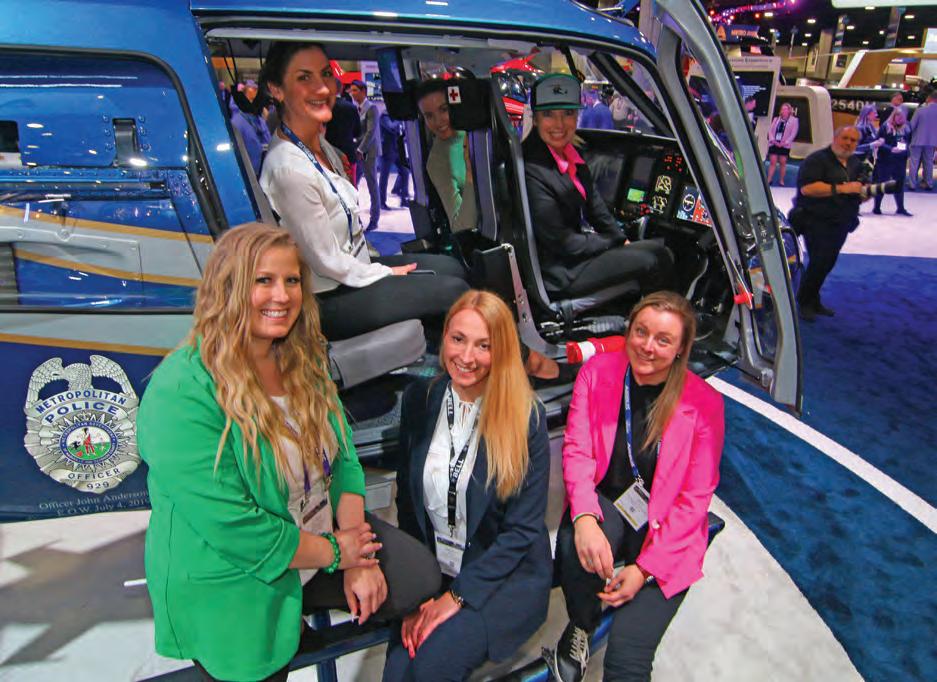

Celebrating International Women’s Day yesterday, an impromptu gathering of the best and the brightest of the helicopter industry’s talented women took a timeout from the busy Heli-Expo show to pose for AIN

The helicopter sector lags behind other industry segments that have recognized a severe workforce shortage, agreed panelists participating in an “Embracing Equity” discussion on Wednesday during Heli-Expo.
The panel, held in celebration of International Women’s Day, was moderated by J en Boyer, a principal of Flying Penguin
Communications and a helicopter pilot, and included six other women that hold a range of positions within th e industry.
Boyer kicked off the discussion with findings of the 2022 Women in Aviation Advisory Board report that women account for less than 20 percent of the aviation workforce, fewer than 10 percent of licensed pilots, and 2.7 percent of mechanics. “What’s more, even in mid-career, there’s a dearth of leadership development opportunities for
women,” Boyer said, noting the numbers dwindle for women in higher-level positions. “Corporations are making changes, but the helicopter industry is far behind,” she said.
Women in Aviation International CEO Allison McKay addressed the industry’s failure to retain talent, suggesting a need to attract a more diverse demographic. McKay pointed to airlines’ creation of their own flight and maintenance schools as an example of how other segments have reacted to shortages.
“They are reaching into communities that have never really been exposed to aviation either,” she said. “So they’re trying to tap into the full market that is the workforce as opposed to just looking at traditional segments.”
Advanced air mobility (AAM) revolutionaries took center stage at the Heli-Expo show this week, sharing their lofty plans for deploying eVTOL vehicles to revolutionize the way people and things get moved around. Assuming the pioneers can meet their ambitious targets for achieving type certification, the first commercial services could take to the air in 2025, and they are already painting an increasingly vivid picture of what the new wave of air transportation will look like.
Part of the picture includes the Norwegian Air Ambulance Foundation, which on Wednesday announced a partnership with Airbus to devise ways to deploy the manufacturer’s in-development CityAirbus NextGen aircraft for emergency medical flights. “The Foundation has always been at the forefront of medical innovation, most recently with dedicated research to integrate a CT scanner into a five-bladed H145 helicopter,” said Balkiz Sarihan, head of urban air mobility at Airbus. “We’re looking forward to working with it as a strategic partner to further develop the exact missions where our eVTOL’s capabilities
would contribute to protecting citizens and making sure they can access effective healthcare in Norway.”
The not-for-profit group’s Leif Olestad told reporters at a briefing on the show floor that he and his colleagues want to identify ways to “deliver improvements to the rescue chain” that go beyond what helicopters achieve now, by shortening response times and improving outcomes for patients.
Explaining how Norway’s distinct and rugged geography requires versatile forms of air mobility to serve a mix of urban and rural communities separated by mountains and fjords, Olestad said new applications of advanced technology are the best response. “We don’t know yet what this could look like, but building the use cases for eVTOLs is a good first step,” he said. “We need optimism, realism, and knowledge.”
All of those attributes showed in HAI’s AAM Leaders panel session, which included executives from eVTOL developers Archer Aviation, Beta Technologies, and Jaunt Air Mobility. Attendees also heard from two prospective operators, Blade Air Mobility and Bristow, as well as from the FAA on how the
agency’s new Innovate 28 program aims to support initial trial operations in several U.S. early adopter communities by 2028.
Blade president and general counsel Melissa Tromkiel explained how the rideshare booking platform will deploy eVTOLs across its network of Part 135 operators to provide on-demand flights in vehicles carrying up to four or five passengers. With New York City already identified as an early use case for its business model, she revealed that Blade is also working on possible routes in and around Vancouver on Canada’s west coast and along France’s Cote d’Azur.
At Bristow, chief transformation officer David Stepanek is expanding the scope of the long-standing helicopter operator’s business-to-business model. He stressed that eVTOLs will not replace its existing rotorcraft fleet, but rather provide, “a parallel path to open things up for passengers.” He called on his fellow AAM trailblazers to share the load in developing AAM’s ecosystem by “collaborating on safety and operations and then compete on the commercial side.”
Last year, Bristow made a commitment to add up to 55 of Beta’s Alia 250 eVTOLs to its fleet, and the manufacturer recently conducted a trial flight at New York-area Westchester County Airport with Blade. “Our biggest focus is on how we bring this [AAM] to market safely, and we’re sharing data with the regulator to drive the path to safe and

Leonardo strategic network of partnerships is integral to operations and enables business growth. A committed system of maintenance repair, overhaul centres provides civil and military customers with line and base maintenance services, ensuring continuous support either at Leonardo-owned or customer’s facilities, worldwide. Leonardo invests in performance and infrastructure to strengthen network collaborations and expands its portfolio of helicopter solutions, with the highest quality of service and the latest-generation technology to support customers’ operations and aircraft maintenance.
Visit us at HAI HELI-EXPO, Booth B1005

Guardian Mobility and Flightcell International are introducing a new Iridium Certus 100 communications system that supports both satellite and cellular mid-band data and voice services for rotorcraft and light fixed-wing aircraft. The new package combines Flightcell’s DZMx cellular and satellite voice, data, and tracking system with the new Guardian Mobility G6 Iridium Certus 100 satellite terminal, adding 88 kbps bi-directional satellite data connectivity.
According to Guardian Mobility (Booth C4012), the one-box G6 unit provides an effective size and weight combination for installations on smaller aircraft. “This solution complements Flightcell’s cellular connectivity and will offer new features, capabilities, and cost-effective aviation satellite communications
that have not been seen before in this market,” said Flightcell vice president Hamish Neill.
The new Iridium Certus 100 system will be available to customers from the middle of this year. According to FlightCell (Booth C3811), operators will achieve significant cost savings while routing data through its DZMx cellular unit and by using the 88 kbps data link of the G6 Certus satellite service when a cellular connection is not available.
Guardian says the G6’s uplink speed suits data transmissions from aircraft, including email, flight following and data monitoring, medical device data, images, and compressed video. Other benefits of the package include the Iridium Messaging Transport service, which optimizes data transport for small to moderate-sized messages, allowing increased data and lower costs compared with the Iridium Short Burst Data service. z
Airbus Helicopters (Booth C2803) added to the rolls of its HCare customer support program at Heli-Expo, announcing new deals with operators of a combined 37 aircraft. New customers include 2MH Jet Systems Group of six H125 turbine singles; Helisul in Brazil for 23 H125s; Henrimar in Brazil for six H125s; and EFAI in Brazil for two H125s.
“It is our privilege to partner with so many different operators, helping them boost the maintenance and performance of their aircraft to carry out their essential daily missions,” said Airbus Helicopters senior v-p for program support Laurent Vautherin. “Each of these HCare In-Service packages has been tailored to provide our customers’ fleets with the optimal level of part availability commitment in the form of part-by-the-hour solutions to best meet their specific operational needs in one single contract.” M.H.

Airbus expects yet another technology demonstrator, called Racer (rapid and cost-efficient rotorcraft), to fly in the second half of 2023 after supply chain constraints forced the most recent first-flight delay from 2022.
The high-speed demonstrator, which will fly as fast as 400 km/h (216 knots), features two pusher propellers mounted to a fixed double wing, or “wing box,” and a five-bladed main
rotor. The unique wings actively enhance the helicopter’s performance by providing additional vertical lift and the ability to fly farther and faster than conventional helicopters. At cruise speed, roughly half the helicopter’s lift comes from its fixed wing. Meanwhile, its asymmetric tail boom produces a performance gain of up to 10 percent in hover.
A pair of 2,500-shp Safran Aneto-1X engines provide 25 percent more power than similar-size engines, according to Airbus. The demonstrator can achieve up to a 15 percent reduction in fuel burn when the pilot places one of the two engines in standby mode
during cruise flight—a configuration Safran calls “eco mode.”
Racer builds on the expertise Airbus Helicopters developed with its self-funded X3 high-speed demonstrator, another compound rotorcraft design that set a speed record in June 2013 of 255 knots in forward flight.


“The X3 demonstrator showed that high speed, highly efficient results can be obtained when the main rotor’s rotational speed is slowed down during forward flight and thrust is provided by propellers mounted on a wing that provides lift,” explained Airbus Helicopters director of research and innovation Tomasz Krysinski.
For the Racer demonstrator, in part funded by the Clean Sky 2 European research program, Airbus placed the propellers on the back of the box-wing in a pusher arrangement (compared to the forward-mounted puller configuration on the X3), reducing the power required during forward flight by 10 percent, thereby further lowering fuel consumption and increasing flight range. z
Each Enstrom helicopter is engineered and assembled by an elite team in the heart of the America. We strive to build one of the safest, most dependable, and versatile helicopters in the world – all while maintaining the unparalleled support and expertise that have made us authentically Enstrom for over 60 years.
you patrol the skies, tend to farmland, travel, or are training the next generation of pilots, Enstrom will always work for you. New Enstrom helicopters will be ready to fly this year – start building yours today!
For Robinson Helicopter (Booths B4048, B3420), this will be a bittersweet year. While the Torrance, California-based OEM celebrates its 50th anniversary in 2023, it will do so without the man who founded the company in 1973, as Frank Robinson, the legendary patriarch of the family-owned business, died this past November at the age of 92.
Over the past year, the manufacturer increased its production of helicopters, delivering 258 compared with 244 in 2021. “That was a good thing, but it was sure a lot of work to get there,” said company president Kurt Robinson, noting that lingering post-Covid supply chain constraints served to limit the company’s output. While the airframer has worked to become as self-sufficient as possible at its 600,000-sq ft-production and asse mbly facility at Torrance’s Zamperini Field, manufacturing everything from wiring harnesses to rotor blades, Robinson expressed frustration about the wait for some of the longer lead-time components not made in-house, such as bearings.
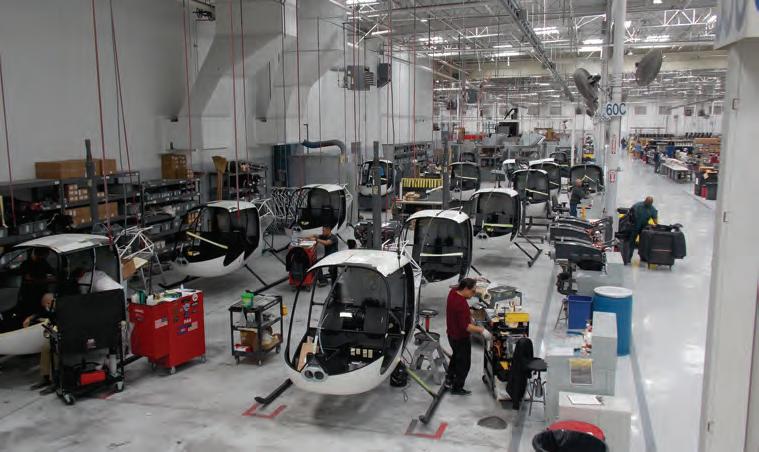
“A lot of it was as we saw that production needed to increase, [we were] trying to get not only the parts that we already ordered but also increase the quantities that we needed,” he told AIN. He added that he would go into Monday morning production meetings not knowing which bottleneck he would need to address that week. “I think most of those are resolved; I’m certainly getting fewer and fewer of those as time goes by, and that’s allowing us to speed up the line that much more.”
In 2021, the company set a milestone when production of the R66, the company’s only turbine-powered offering, exceeded its popular piston-powered R44 Raven II. That trend has continued with delivery of 101 R66s in 2022 compared with 86 Raven IIs. As for the rest of the R44 line, Robinson last year produced 51 Raven Is and 5 Cadets. It also added 15 R22s.
“We currently have over 350 helicopters on back order, so if last year we did a total of 258, you can see we’ve got some work getting our production up,” noted Robinson. While most manufacturers view backlog as production security, Robinson takes a different tack. “It’s nice, but it’s bad because we want to get the helicopters out as quickly as we can to everybody,” he explained. The rotorcraft maker’s production rate stands at three R66s a week, 3.5 R44s per week, and one R22 every two weeks.
Attractive jobs at Robinson in the postCovid environment has allowed the OEM to add 50 new employees over the past year, increasing its workforce total to 1,020 at the start of 2023. “We are continuing to hire and expand,” said Robinson, noting that the recent worker shortages are resolving as well. “We’re a little picky on who we bring in here, but it’s working out as we move forward.” At the moment the company runs two shifts at its factory.
For this year’s Heli-Expo in Atlanta, Robinson (Booths B3420, B4048) brought three
of its helicopters to display at the Georgia World Congress Center. The fully equipped examples include an R66 with the newly introduced pressure refueling system. The $18,000 option allows for rapid refueling in operations such as agriculture spraying or Bambi bucket use, where the operator requires quick ground turnarounds. “We’ve had quite the demand for it, so we’re pleased to have this out, and you will be able to see it at the show this year,” said Robinson. While not on display this year, a night-vision goggle (NVG)-compatible cockpit for the R66 in law enforcement use recently received FAA certification. Last fall Robinson delivered the first of two factory-outfitted examples ordered by the Polk County (Florida) Sheriff’s department.
A pair of R44s—a Raven II and a Cadet— both equipped with a recently-introduced electronic ignition system, round out Robinson’s display. “That is going in all the piston aircraft and that improves the starting of the aircraft, and it eliminates the 500-hour [magneto] inspection so we believe it enhances the aircraft with increased reliability and also reduces maintenance,” Robinson explained. While the feature was actually available starting around the end of 2021, the first production examples suffered reliability shortcomings that Robinson says it has long since resolved with the system’s manufacturer. z
 by Peter Shaw-Smith
by Peter Shaw-Smith
Vision Systems (Booth B3101), which has 20 years of dimmable-glass expertise, is displaying a selection of windows and accompanying flipping, sliding, and jettisonable mechanisms at Heli-Expo. According to the company, the products offer excellent mechanical properties, resistance to vibration and impact, and high optical quality and are aimed at various helicopter types.
“Vision Systems will also showcase its electronically dimmable windows, a high-end shading and privacy system using SPD (suspended particle device) and PDLC (polymer dispersed liquid crystal) smart glass technologies,” it said. SPD allows glass or polycarbonate to turn from opaque dark to transparent in milliseconds to regulate daylight, glare, and heat entering an aircraft.
“PDLC solutions provide an instant switch between transparent and opaque white without blocking visible light for immediate privacy while enjoying daylight,’ noted the company. “Both technologies can be combined into one window, with or without segmentation (such as a Venetian shade effect) for various customizable possibilities. They enhance visual, thermal, and acoustic comfort for a greater passenger experience.”
The company claims its dimmable windows offer many advantages over other systems, such as allowing infinite variable shading and instant response time and automatically switching to their darkest possible state when unpowered. This keeps the interior of the rotorcraft cooler on the tarmac and reduces air conditioning consumption. “An integrated IR barrier further strengthens heat blockage,” Vision Systems said.
The windows also block out more than 99.9 percent of harmful UV light, even in transparent mode, to protect passengers and prevent interior equipment from fading. Fabrication involves multiple layers of noise-attenuating films to keep the cabin quieter.
“These smart shading systems provide a strong competitive advantage in terms of aftermarket,” Vision Systems said. “They use ultrathin, lightweight, scratch-resistant composite glass, saving interior cabin space and delivering superior optical performance. Furthermore, in addition to being silent, light, and compact, these solutions have no moving parts, reducing maintenance and downtime compared to shades.”
Vision Systems is also presenting one of its latest innovations for ambiance creation and personalization of passenger space, a smartglass partition between pilot and passengers, consisting of a switchable projection display showing messages, images, or videos. “When nothing is displayed, this divider can remain
transparent or opaque (white or dark) to offer more privacy,” it said.
Tel Aviv, Israel-based Gauzy, a material science and nanotechnology developer, acquired Vision Systems in February 2022. The Gauzy subsidiary is based near Lyon, France, with production and sales facilities in Florida, and trade offices in Singapore, Dubai, and Montreal. It is a supplier that designs, produces, and markets bespoke solutions for the aerospace, land transport, and marine industries.
“Vision Systems has developed a comprehensive know-how to create built-to-spec robust, compact, lightweight, plug-and-play solutions with various options for customization,” it said. “The company masters different processes such as resin transfer molding, thermocompression, thermoforming, and draping, alongside being specialists in mechanics and electronics.”
Its product range includes cyclic sticks, interior linings, sun visors, electric composite footsteps, bad-weather windows, jettisonable composite frames, electronically dimmable windows, and smart partitions. z

When you meet a true believer in the power of technology to transform an industry you care about, it’s hard not to get re-energized by their fervor and focus. Vertical Flight Society (VFS) executive director Mike Hirschberg is just such a believer, but his strong engineering background has helped him to soberly assess and support the transformation now underway in the sector as new eVTOL aircraft approach the market.
The VFS, which morphed from the American Helicopter Society in 2018, was one of the first professional bodies to see the potential for distributed electric propulsion and autonomous flight capability to support cleaner, quieter, and more cost-effective forms of vertical lift. “It was around 2013 that a number of our people started getting very excited about this and saw it as having a lot of potential, so we started a series of workshops around the theme of transformative vertical flight,” Hirschberg reflected.

Ten years later, what increasingly became known as urban or advanced air mobility stands at the forefront of much of the VFS’s mission, as reflected in well-supported events such as the Electric VTOL Symposium and the Autonomous VTOL Technical Meeting held in Mesa, Arizona, in January. In May, the group will hold its 79th Annual Forum & Technology Display in West Palm Beach, Florida.
The VFS differs from many industry associations in having a membership base of individuals, with around 6,400 such members in industry, academia, and government from around the globe. It also counts 180 corporate members, and that tally has grown significantly over the past six years.
Among their numbers are eVTOL aircraft pioneers Joby, Archer, and Lilium, all of which quickly have risen through the ranks from the small business category to become “gold” members. That means they are just one step in the society’s hierarchy below the long-established
“big five” helicopter manufacturers, namely Bell, Sikorsky, Airbus, Leonardo, and Boeing.
Hirschberg sees no tension in having the eVTOL crowd under one roof with their older rotorcraft cousins (some might say ancestors).
“If you need to hover for a long time the helicopter is still the best solution with its large disc area and large-diameter rotors,” he told AIN. “But there are specific applications where an eVTOL is a better solution. We think helicopters will be around for a long time.”
The VFS has provided a supportive environment for the advanced air mobility revolutionaries as they have progressed their plans with a touch of bravado not normally associated with the more conservative elements in the aviation industry. “This is not a get-rich-quick scheme; we’ve been saying that for a long time,” Hirschberg said. “It takes a decade, $1 billion, and a thousand engineers [to get a new eVTOL aircraft certified] before you start getting any revenues.”
In his view, some of the eVTOL leaders will succeed over the next few years, despite the limitations of some aspects of the supporting technology. “Batteries still suck compared to fossil fuels, with only about 5 percent of the energy density, so it will be a relatively narrow niche,” he commented. “On the other hand, helicopters cost a lot of money because they tend to be in the hangar [not earning money] most of the day.”
The VFS has also advanced a case for hydrogen propulsion that it hopes could deliver on both the net zero carbon objectives of the industry and cost-effective levels of performance for aircraft. In May 2020, it formed the Hydrogen-Electric Vertical Takeoff and Landing (H2eVTOL) Council, which recently spun off into a new independent nonprofit organization known as the Hysky Society, led by advanced air mobility entrepreneur Danielle McLean.
Along with advocating for hydrogen as a clean and sustainable energy source for the aviation industry, the Hysky society will do public
outreach work to educate the general population about the benefits of hydrogen-powered eVTOL aircraft and how they can shape the future of transportation, according to VFS.
Monthly meetings previously held by the H2eVTOL Council will continue on the third Monday of every month, but the meetings will henceforth be referred to as “Hysky Monthly.” The Hysky society is now accepting new members. Those interested in joining can sign up via Hysky’s website. The organization also accepts donations.
“I’ve always said that there are a thousand reasons why eVTOLs won’t work and the same is true of hydrogen,” Hirschberg commented. “What we’re trying to do is bring people together to make it work.”
In the bigger picture, the VFS has just released a new strategy document to define its future objectives. One of the biggest items on the to-do list is helping the vertical flight industry recruit 10,000 or more engineers.
The society firmly believes in taking a diverse approach to recruiting newcomers to an industry that many have considered somewhat traditional and one-dimensional in terms of its talent food chain. “If we keep doing the same thing over and over we’ll just get the same people, so we can’t afford to exclude people of diversity,” said Hirschberg. “We’re trying to reach out to schools and universities that haven’t generally been approached [to contact students].”
As he prepares to step down as VFS executive director in mid-2023 to assume a new role with the society, Hirschberg firmly believes that the vertical flight sector will succeed in re-inventing itself. Does that mean he believes the front-runners in the eVTOL aircraft race to market will achieve their ambitious timelines to start commercial air taxi services barely two years from now?
“We know we can get people to fly in eVTOL aircraft, and it’s a matter of when not if,” he concluded. “This is as revolutionary as going over to the smartphone. We think we’ll look back on the first wave of eVTOLs and say how limited they were, but 2025 is not the finish line, it’s just the beginning in giving birth to this revolution.” z
We train you to stay sharp, fine tune, and always be prepared—for whatever the next flight throws at you. This kind of training is more than fulfilling a requirement. It is an achievement. And it’s reserved for the sky’s most elite. FSI. Nothing short of excellence.
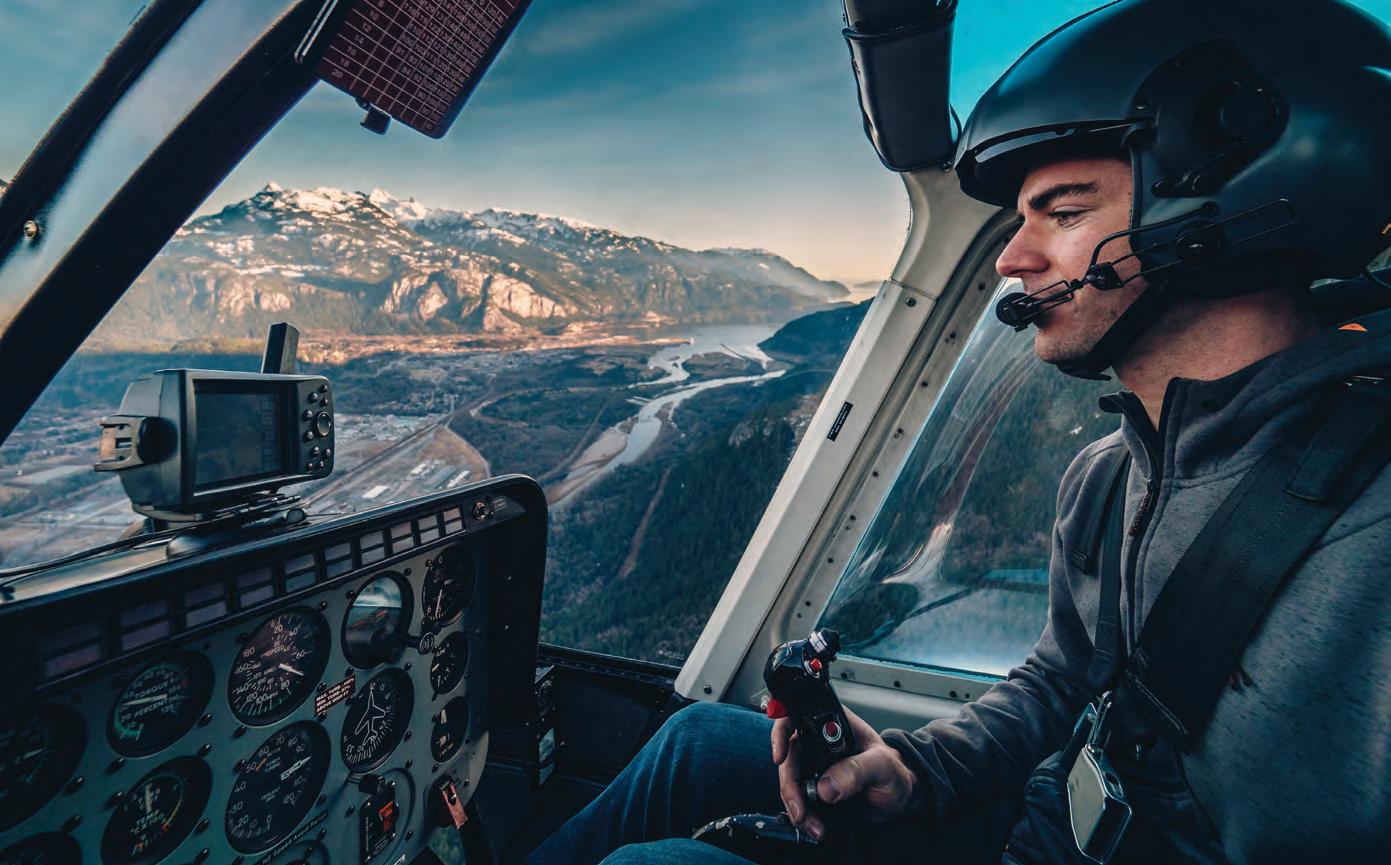
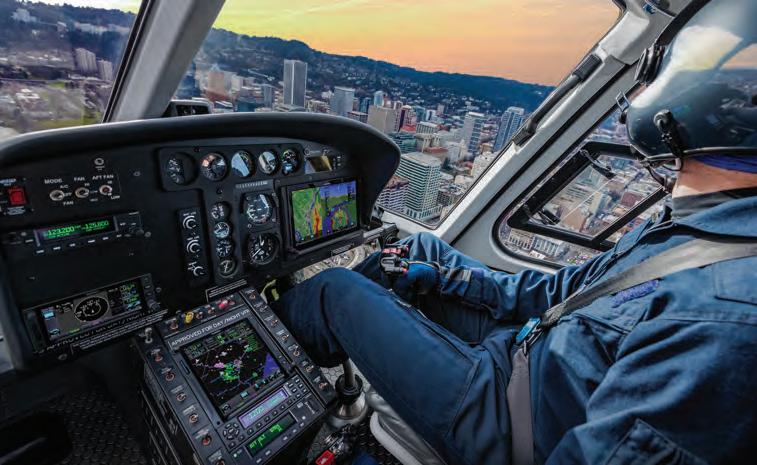 by Mario Pierobon
by Mario Pierobon
The life cycle of a helicopter lasts several decades, and helicopters can maintain their economic viability well into their lifespan. But as technology in general develops, at some point helicopter equipment becomes obsolete. Avionics upgrades in particular offer opportunities for obsolescence management to operators of older machines.
According to Pat Coleman, manager of aviation aftermarket sales for the Americas at Garmin (Booth 5020), operators look for safety enhancements for their missions, enhanced quality and reliability, modernization, simplified operations, increased int egration, weight savings, reduced cost of ongoing operations, and flat-rate repairs.
Bedford, Texas-based Reb Technologies (Booth B5315) has opened an international division that focuses on avionics upgrades
called REMS. “Our goal is to provide a clean crew station with the information needed to ensure safety of flight, particularly safety in the critical phases of flight,” said Jeff Stubbs, Rebtech senior v-p of operations and systems technology. “The biggest issue we see today is that companies—and more so governments— are still doing business as they were pre-Covid. Aviation took a pretty sizeable lump during the pandemic; spare parts are rare and when they are available, one has to jump. We are seeing an increase in avionics obsolescence due to sub-vendors closing and key subcomponents no longer available.”
Helicopter operators must consider the return on investment for upgrade options when considering an avionics system, said Universal Avionics CEO Dror Yahav. “Some cost-saving benefits are easily recognized, while others require further analysis,” he explained. “Obvious benefits include enhanced mission capabilities,
which increase efficiency and allow operators to do more. Other system enhancements may [involve] operations with flight planning and performance improvements to save time and reduce costs.”
According to Chris Polynin, director of product management at L3Harris Commercial Aviation Solutions (Booth C2431), interoperability with existing systems is a critical requirement of helicopter operators. “They need the ability to add a new capability without a wholesale replacement of the existing cockpit,” he said. “Our products, for example, are designed to play well with others, utilizing standard interfaces. The Navy and oil industries require tactical navigation systems, and we have operators using our TACAN+. For offshore helicopters, TCAS is in demand because of reduced visibility and dense traffic. Just in the Gulf of Mexico, there are about 2,500 sorties per day.”
Andrew Barker, vice president of integrated avionics at Honeywell Aerospace (Booth B808), explained that the two primary drivers of helicopter avionics upgrades are analog instrument obsolescence and the need for improved situational awareness, which suppliers can satisfy by adding synthetic vision and terrain to the cockpit displays. “The addition of an integrated radar altimeter and ADS-B traffic information services/flight information services on the primary flight display are also significant contributors,” he said. “In addition, navigation upgrades such as wide area augmentation system and certified class B terrain are also drivers of the upgrades. Depending on the operator, they may look for a few or potentially all features.”
Some less easily recognizable cost benefits can come from the maintenance areas of the operation, noted Yahav. “Older antiquated avionics may require more frequent, costly repairs due to their age,” he said. “There may be a significant reduction in component weight when upgrading to newer avionics suites, once again, improving capabilities and reducing operating costs. There may also be a reduction in required spares to keep in stock and an increase in repair capabilities of the newer, non-antiquated equipment. All of these can be rolled up into an extremely hard to value but nonetheless very valuable benefit of safety in all operations.” z




Hill Helicopters CEO Jason Hill says he is completely convinced that he can build the GT50 turbine engine for his new HX50 helicopter for less than the price of a new Lycoming IO-540 six-cylinder piston aviation engine, even for less than $100,000 each. And where did he get this ambitious idea? In part, from the late Frank Robinson.
A quarter century ago, then 20-year-old Hill worked three jobs to save the $10,000 he needed to come to Long Beach, California, from the UK and get his helicopter license in a Robinson R22 over the course of six weeks. While in California, he arranged to meet Robinson at the company factory in Torrance. Hill, then an aeronautical engineering student, dreamt of building his own production helicopter and he wanted to talk to someone who actually had done it.
Hill recalled the meeting. “I dutifully turned up with my little book full of questions and stood there and grilled him in the lobby,” he said. “He was very polite and very generous with his time. He answered all of my questions and put me right on the things I got wrong. And he gave me what I thought was a knowing look as to why I was asking those questions because he probably asked those same ones himself a few years earlier. He made me believe that I could do this. It was one of the most formative moments of my life.”
Hill Helicopters aims to fly the HX50 for the first time later this year. Hill’s immediate market, first for the kit-assembled HX50 and later a fully-certified version, the HC50, is supercar buyers—private individuals with the means to spend up to $1 million or more on a discretionary purchase. But even with such rarified clientele, Hill sees a need for economy, and that centers on the engine. Hill called available engines “unreasonably expensive,” giving his company “no choice” but to “think bigger.”
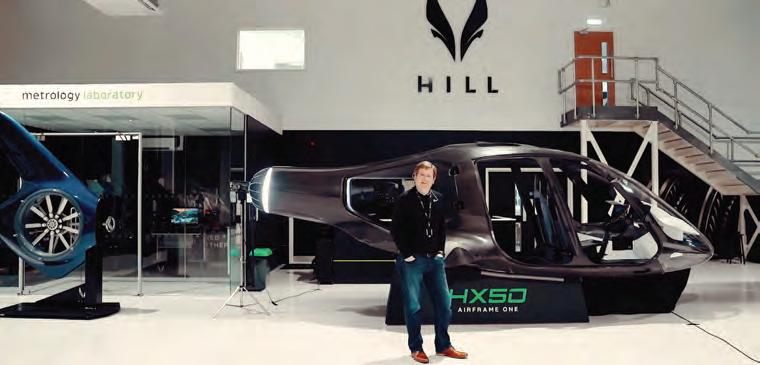
“The GT50 is being designed and tested to the latest revision of EASA and FAR certification standards, which is a higher standard than any existing certified light aircraft engine. Our
test engines will be run through full-life testing on the bench and our prototype aircraft will be flown for their full-service life as part of our ongoing shakedown testing,” Hill told AIN. Building the engine in-house exemplifies another example of Hill’s commitment to lean, vertically-integrated manufacturing, he added.
“The commercial forces here are much bigger than the engineering problems we have to solve,” said Hill. “In terms of the engine, there are really two sides to it: it really doesn’t cost all that much [comparatively] to develop these engines, but it becomes ludicrously expensive [when people only use the engine for a single purpose]. The [capital expenditure] gets very big very quickly. The key is just making sure that you can sell enough helicopters so that [the engine cap ex] becomes a smaller cost per helicopter. It comes back to the price point—you’ve got to be able to deliver the aircraft at a price point that commercial operators can finance it and make a living, and that private owners can afford to buy and not be crippled by the depreciation because of the calendar maintenance that is looming around the corner.”
Referencing the engine, Hill explained his team began with performance targets including the ability to carry five 210-pound passengers and their luggage, cruise for three hours, and
hover out-of-ground effect (OGE) at 10,000 feet msl on ISA plus 15 deg C temperature days. “That set the parameters for the engine,” Hill said, adding he aims for the GT50 to produce 400 shp max continuous, 440 shp for five minutes, and 500 shp for 30 seconds. That power provides enough margin to get pilots “out of trouble,” he said. While the GT50 traces its origin in an industrial engine to provide “low development risk,” the design has been modified for the helicopter. An annular combustor replaced the three-chamber combustor to improve the size of the package and reduce weight. Hill replaced the two-stage turbine with a single-stage model that is slightly higher loaded. It also optimized the secondary air system to improve cooling.

Hill is building parts for the first engine now and plans to build “three or four” more in the course of bench testing and validating the design and performance before it finds its way onto the aircraft. Hill said he thinks he can get individual engine cost below $100,000 “easily” based on a run rate of 500 helicopters a year, the company’s ultimate production goal. He does not see the need to offer the GT50 engine for other applications to make it economically viable, he further noted.
While admitting the road ahead, both for the helicopter and its engine, is ambitious, Hill remains confident of success. “It’s just like eating an elephant: one bite at a time,” he concluded. z
Loft Dynamics gave AIN editor-in-chief Matt Thurber a chance to fly its full-motion virtual reality (VR) simulator at Heli-Expo to demonstrate how accurately it replicates the Airbus A 350B3e/H125 helicopters. During the demo, Thurber got to experience full immersion in the VR environment. Here, he describes the experience.
by Matt ThurberLoft Dynamics’s simulator holds EASA flight simulation training device (FSTD) FTD Level 3 authorization (equivalent to FAA Level 7 FTD). It became the first company to receive EASA FNPT II authorization for its motionbase Robinson R22 VR simulator in 2021.
The Loft VR design not only replicates the cockpit and the real world in any direction that the pilot looks but it allows for animation of the occupants. This means the pilot wearing the VR headset can see his or her own “artificially represented body,” that is, hands and feet manipulating the controls and moving buttons and switches. That is an advantage of the VR environment, according to Fabi Riesen, co-founder and CEO of Zurich-based Loft (Booth C2610, formerly VRM Switzerland). “Virtual reality is important to give the pilot full immersion,” he explained.
The Loft simulator mounts on an electrically driven 6-degrees-of-freedom motion platform developed in-house by Loft engineers, adding to the realistic flight characteristics. The H125 simulator at Heli-Expo is equipped with standard instrumentation, but Loft is also developing an optional cockpit with Garmin G500H TXi and GTN 650Xi touchscreen displays. Another VR advantage is that Loft can design the cockpit with touchscreen displays that replicate the real avionics, but the real avionics hardware isn’t needed as all the action takes place in software.
During the demo of the H125, I was able to experience full immersion in the VR environment. The simulator operator/instructor
sits at a three-screen console in front of the simulator where he can see what the pilot sees while wearing the Varjo VR headset.
With the headset on and adjusted to assure proper alignment and resolution, the operator performed the takeoff and then handed off the controls to me one at a time, beginning with the collective, then pedals, and cyclic. We were immersed in a daytime view of a valley surrounded by Swiss mountains.
The controls were just as sensitive and responsive as the real helicopter, which I have
when the operator switched on turbulence, starting with mild, then moderate, and finally a few seconds at the severe level.
I tried a visual approach to a hover, but misjudged the height of the helicopter and bounced off the runway surface. I should have paid more attention to the runway elevation and watched the altimeter, but I was having too much fun flying and looking outside. I’m sure it wouldn’t take long to get used to flying close to the ground, and after removing the headset, I just wanted to spend more time in the simulator.
As it did with the H125, Loft is working with Airbus Helicopters on replicating the flight dynamics of the H145 for its next simulator. The R22 sells for roughly $200,000, while the H125 costs less than $1 million, according to Riesen.

The first H125 delivered to a U.S. customer went to Colorado Highland Helicopters in
flown. But what was fascinating was that I could see my animated hand reaching for the instrument panel to adjust the lighting settings when the operator changed the outside view from day to night. He demonstrated how the operator can gradually or instantly change visibility from VMC to IMC, which is tremendously helpful for training pilots to handle inadvertent IMC encounters. The motion platform added a lot of fidelity to the experience, especially
Durango, Colorado. Along with high-altitude and initial training, the company uses the simulator to train pilots on external loads. Company owner and chief pilot Brandon Laird said that learning external loads in the simulator gives pilots more time to learn how the helicopter reacts without the risk and high cost of training in the machine. Students are soloing in the real helicopter in only five “blade” hours after training in the simulator, he said. z
Leonardo’s order book for the AW09 turbine single pushed past 50 on Tuesday with the announcement of new deposit-backed reservations for the helicopter from customers including Brazil’s Aero Service Representação, Helitech Asia, Safomar in South Africa, Diskopsa in Panama and Guatemala, Heliflite in Oceania, and Aero Facility in Japan. The company declined to specify the number of aircraft ordered by each customer. The order news comes less
than two months after Leonardo announced an engine change for the helicopter to the Safran Arriel 2K. Emilio Dalmasso, Leonardo senior vice-president of new products business development, said the company expected the AW09’s order book to top 100 by year-end and could hit 200 before anticipated certification in mid-2024. A company spokesman stressed that the 200 number was not a minimum threshold for serial production, merely a forecast based on demand trends.
Also on Tuesday, Leonardo
FreeFlight Systems has appointed AvPanels as a preferred reseller of its Terrain series of radar altimeters designed to avoid disruption by spurious 5G C-band network interference. The manufacturer says the new equipment, using digital signal technology, is the first major upgrade to radar altimeter radio frequency circuits in decades and weighs 60 percent less than current devices.
Operators of rotorcraft including the Robinson R44, Bell 206/407, Airbus AS350, and MD Helicopters MD 500/530 can now order the Terrain RA-5500 units for single installations, the RA-6500 for dual installations, or opt for the RA-4500 Mark II unit as a drop-in replacement for existing RA-4000 or RA-4500 equipment. FreeFlight (Booth B1420) said it intends to have supplemental type certificates in place for other models by mid-May.
“We are seeing increased demand for 5G-tolerant radar altimeter solutions across rotorcraft, business aviation, and advanced air mobility markets,” said FreeFlight sales and marketing vice president Shane LaPlante. “We understand the criticality of safe continued operations in the face of airworthiness directives and are excited to extend these solutions to law enforcement, air medical, search and rescue, and other operators that navigate dense urban centers.” C.A.
(Booth B1005) announced an agreement with helicopter air ambulance operator and completion center Metro Aviation to collaborate on the promotion of the AW09 to the EMS market and the development of aircraft interiors, STCs, service, and training for the helicopter. “Combining our industrial capabilities
with Metro Aviation’s extensive and recognized experience in operations and support enhances the AW09 value proposition, providing superior mission capabilities to the operators of this platform in a prime single-engine market like USA,” said Gian Piero Cutillo, Leonardo Helicopters managing director. z
Operators of MD 530F helicopters now have the option of installing the Foresight MX predictive health and usage monitoring system (HUMS) through a new partnership between GPMS International and MD Helicopters announced at the Heli-Expo show.
The STC to install Foresight MX on the MD 530F came in 2022, and the manufacturer already has installed three systems. The HUMS continuously monitors the helicopter’s engine and drivetrain, providing remaining useful life estimates on trending parts.

According to GPMS (Booth B3214), the system also guides operators on how to optimize rotor track and balance adjustments after each flight and provides flight data monitoring with exceedance alerting. It handles data acquisition and transfer automatically and, by accessing the cloud-based system from any device, operators can monitor their fleet anywhere in the world in real-time.
“The more data our operators can share on health and usage of their aircraft, the better we can support them and keep them flying,” said Ryan Weeks, MD Helicopters’ customer support v-p. “With Foresight MX, the generational leap in HUMS capabilities makes it easy for operators to share details on how the aircraft is performing, which allows MD to troubleshoot and resolve issues faster and improve our spares and repairs forecasting accuracy.” C.A.
A private owner in Spain has become the latest European customer for Bell’s 429 twin-engine helicopter. On Tuesday, the manufacturer announced it has signed a purchase agreement for the aircraft, which will be operated by local sales representative World Aviation on behalf of the undisclosed client.
The 429 will fly corporate transportation and charter services in the Costa del Sol and o ther regions of Spain. World Aviation began in 2014 and has served as an independent representative for Bell since 2020.
The Malaga-based company specializes in passenger and cargo transportation, aerial work, and VIP transfers. It also offers pilot
training, maintenance, engineering, and other operational services.
According to Bell (Booth B5504), the 429 has proved a popular choice for VIP operations in Europe, where it has delivered 90 of the aircraft. Operators in that region also include Heli Securité

(France), Wucher Helicopter (Austria), and Starspeed (UK, Greece, and Cyprus). Swiss operators of the type include HeliAlps, Airport Helicopter, Air Zermatt, and Centaurium Aviation.
“The Bell 429 is continuing to showcase its breadth of abilities

for our European customers— from law enforcement in Sweden and soon passenger transport in the Costa del Sol,” said Patrick Moulay, Bell’s senior vice president for international sales. “The combination of twin engines, IFR capability, and Bell’s BasiX-Pro integrated avionics means the 429 is able to fly in more locations and in a wide range of weather conditions, making it a highly versatile aircraft for corporate VIP missions in Europe.”
The aircraft is powered by a pair of Pratt & Whitney engines, each delivering 625 shp to provide a cruise speed of just over 151 kt. The 429 flies missions including search and rescue, law enforcement, and emergency medical services. A total of 430 units operate worldwide.
Customers can opt for a more luxurious cabin by specifying the Designer Series interior, which includes special options for leather fittings, flooring, and metal finishes, as well as tailored consoles, door accent panels, and headliners. z
Onboard Systems (Booth C2020) is displaying an advanced prototype of its Talon HEC (human external cargo) dual cargo hook kit for the Bell 429 at Heli-Expo 2023.
Launch customer Capitol Helicopters is providing fit-check and flight test assistance for the kit’s certification. Once certified, the kit will provide a certified solution for Part 133 external load missions, including HEC, high-value cargo, utility line work, short-haul, and search and rescue.
With Y-rope attached to both cargo hooks, the system has a load limit of 1,322 pounds for HEC missions. The kit consists of fixed provisions, controls, and dual Talon LC hydraulic cargo hooks mounted to a lightweight frame. It can be installed on an aircraft with no prior cargo hook installation and is also compatible with Bell dual hook factory fixed provisions. The Onboard kit offers improved ground clearance and safety features such as keeperless hooks that eliminate dynamic rollout, a high-reliability hydraulic backup release system, and optional onboard weighing system. z

PHI’s MRO Services division is now a Sikorsky-authorized customer support center for the S-92 and S-76C helicopter models from its Lafayette, Louisiana facility. PHI (Booth C3820) has national and international capabilities and its MRO services range from completions to heavy maintenance. “With 74 years of experience, our entire team, from engineers to maintenance technicians, are ready for anything,” said Tom Neumann, PHI MRO Services president.
“Our customers will benefit from the
advanced service capabilities and technical expertise provided by PHI,” said Leon Silva, Sikorsky vice president of global, commercial, and military systems.
PHI operates 240 aircraft from 70 locations worldwide. PHI MRO Services maintains a wide range of helicopter models and engines and is a Part 145 FAA-approved maintenance center with DAR/DER authorization. It has strategically positioned resources internationally and its teams can meet the requirements of multiple international regulators. M.H.
Helicopter leasing company Milestone Aviation Group (Booth C4431) has agreed to lease four Leonardo helicopters to the German offshore operator HeliService International, the companies announced Tuesday at HAI HeliExpo in Atlanta.
The lease agreements cover two Leonardo AW139s and two AW169s. Milestone recently handed over the first AW139 to HeliService, and plans call for delivery of the second AW139 in April.
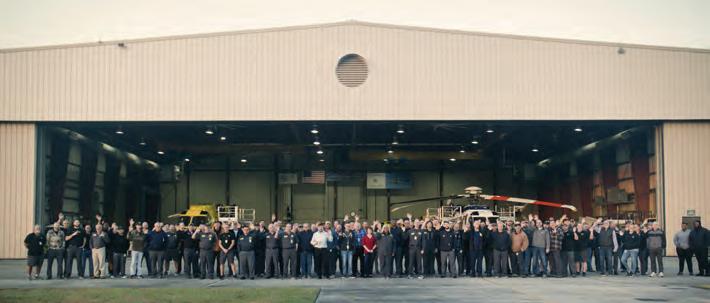
HeliService plans to operate the AW139s at its offshore wind farm at the German Bight in the southeastern region of the North Sea. The AW169s, which Leonardo plans to deliver in mid-2023, will support offshore wind projects in Taiwan, according to Milestone.
“Offshore wind is an exciting growth area for helicopter leasing, and we are delighted to be able to support HeliService as they expand their fleet and services,” said Sebastien Moulin, Milestone’s head of Europe and the Americas. “We look forward to a long and successful relationship with HeliService.”
“The Taiwanese offshore wind market is one of the key global growth markets for offshore wind,” added HeliService CEO Oliver Freiland. “Helicopters are a crucial element in meeting this growth in demand given the vital role they play in ensuring the maintenance of offshore wind turbines, particularly in the harsh sea conditions of Taiwan.” z



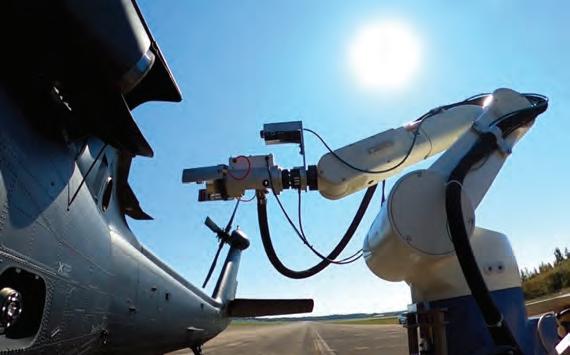 by Hanneke Weitering
by Hanneke Weitering
Robotic refueling and autonomous systems specialist Stratom has partnered with Imenco (Booth B2322), a Norwegian company that makes helicopter refueling systems for offshore activities, to develop an autonomous refueling system for industrial, aviation, defense, and offshore industries.
According to Stratom, the new partnership will provide clients with a safe and sustainable refueling system that will help organizations streamline their operating efficiency, optimize resources, and maximize human capital.
“This partnership is a great opportunity for both Imenco and Stratom to combine their innovative technologies to offer clients a complete remote operating refueling system,” said Ross
Imenco and Stratom will work together to deliver a fully autonomous robotic refueling system for offshore operations.
Toll Helicopters, a Brisbane-based provider of specialized mission-critical helicopter services, has expanded its fleet of AW139 intermediate twin helicopters in Australia with the purchase of two additional units from Leonardo (Booth B1005).
Edmonds, Imenco’s aviation sales manager. “With our FuelScan Series of refueling systems and Stratom’s autonomous capabilities, we can offer a complete refueling, testing, and reporting system that removes the need for human interaction.”
Imenco’s FuelScan products automatically monitor fuel levels
through self-sampling, and its activity logs can be accessed from any location. Under the new partnership, FuelScan will work in concert with Stratom’s Rapid autonomous refueling and liquid transfer system to deliver what the companies say will be the “best-in-class” autonomous robotic refueling system. z
Astronautics Corporation of America and Nova Systems are jointly installing airborne C4ISR mission systems on a Leonardo AW139 helicopter for operation by a European customer for search and rescue and law enforcement applications. The modification will feature Astronautics’s AeroSync Max wireless airborne communication system to
provide avionics and mission data routing, as well as security controls for managing data between the mission system and the helicopter’s avionics suite.
Nova Systems is providing its C4ISR system, which encompasses command, control, communications, computer, intelligence, surveillance, and reconnaissance elements. It recently took delivery of the first AeroSync Max equipment and it now is testing it in its systems integration laboratory before flight testing starts in April to prepare for service entry in late 2023.
AeroSync Max is a secure, integrated wireless data transmission system that provides highspeed-data connectivity, securely enabling flight, mission, and maintenance data gateway applications for new and in-service aircraft. C.A.

Toll expects delivery of the AW139s in the second half of 2023 and to supplement its existing fleet of 10 AW139 helicopters, bringing the total to 12. It uses three to support pilot training, emergency response and disaster relief missions, and other Australian Defense Force (ADF) exercises.
Once delivered, the two new AW139s will fulfill Toll’s contract requirements for two major ADF programs: the Crash Response Helicopter Service program for the Australian Army’s 1st Aviation Regiment in Darwin and the Army Commercial Helicopter program for the 5th Aviation Regiment in Townsville.
The helicopters come equipped with a searchlight, cargo hook, hoist, and electro-optical/infrared sensors, making them capable of supporting a variety of ADF training and disaster-relief missions. They feature an advanced navigation and collision avoidance system to help pilots fly in challenging environments. Leonardo has sold several of the helicopters to Australia for law enforcement and surveillance applications. H.W
Columbia Helicopters is boosting the firefighting capability of its Model 234 Chinooks by offering Coulson Aviation’s RADS-L large-capacity, high-flow tanks as optional equipment. Coulson originally designed the tanks, which can hold up to 3,000 gallons of water or fire retardant, for C-130 fixed-win g aircraft.

Under a partnership announced at the HeliExpo show on Wednesday, the companies
have adapted the RADS-L equipment to the Model 234 heavy-lift rotorcraft, which also performs tasks such as logging and logis tics support. They say it will help operators respond more effectively t
“As the OEM of the Model 234, we are always looking for ways to offer more options and capabilities to our customers, and the RADS-L is an innovative and effective firefighting tool that could help save lives and protect property,” said Rob Roedts, Columbia’s vice president of aircraft solutions.
Chris Baur has succeeded Nick Mayhew as the new industry co-chair of the United States Helicopter Safety Team (USHST).

Baur is the founder of Hughes Aerospace, an air navigation
service provider, and a member of USHST infrastructure working group with expertise in NextGen and global performance-based navigation.
Baur also is a dual-rated ATP/ CFII with more than 15,000 hours of flight time in fixed
Coulson Aviation will fit its RADS-L tanks to Columbia’s Model 234 Chinook helicopters.
Like Columbia (Booth 6427), Coulson has been in business for more than 60 years as an aircraft operator as well as a designer and manufacturer. It operates permanent bases in the U.S., Australia, Canada, and Chile. z
and rotary-wing aircraft. He has served in the U.S. Army, Air Force, and Coast Guard and is a senior captain for a major U.S. air carrier. He holds a BS degree from Embry-Riddle, an MBA from Brown University, and is a Fellow of the Royal Aeronautical Society. He begins his new role at
Heli-Expo 2023.
The USHST formed in 2013 to lead government and industry cooperative efforts to promote safety and reduce civil helicopter fatal accidents. It serves as a regional partner with the worldwide Vertical Aviation Safety Team (VAST). z
Reb Technologies (Rebtech) last month received an FAA supplemental type certificate (STC) to install its night vision lighting on a UH-60A helicopter operated by HeliStream. The California-based operator also has ordered the equipment for installation in its Bell 205. The work has begun at Rebtech’s facility in Bedford, Texas.
According to Rebtech president Richard Borkowski, its night vision lighting has become a popular option for the UH-60A. HeliStream is an existing customer for other modification projects using Rebtech lighting systems, for which it now holds more than 30 FAA STCs and also approvals from European regulator EASA. Rebtech (Booth B5315) has conducted equipment installations for customers in Africa, Asia, Europe, and Australia, as well as in South, Central, and North America.
“Working with Rebtech to equip our UH-60 with night vision modifications was an easy decision,” said HeliStream director of maintenance Golden Anderson. C.A.
HAI has issued its Roadmap of Advanced Air Mobility Operations in cooperation with Crown Consulting and the HAI Advanced Air Mobility Advisory Council (AAM-IAC). The Roadmap identifies near-term, mid-term, and long-term scenarios for AAM and specific goals to gain public acceptance and regulatory approval.
Specifically, the document serves as an aid to coordinate and communicate the priorities
of HAI AAM-IAC members; inform regulators of identified challenges and solutions; assist the development of harmonious global standards; and raise awareness among the general public of the possibilities enabled by AAM.
The roadmap addresses multiple areas including infrastructure use, development, and oversight and associated charging and electric requirements; regulations and airspace use including the need to develop flexible and performance-based rules for airspace
Nigeria’s helicopter fleet will expand under aircraft deals confirmed at this week’s Heli-Expo show in Atlanta by sales group Rotortrade. The global preowned distributor for Leonardo announced the sale of three AW109s to Global Aviation Training and Maintenance in the west African country and the acquisition of a pair of Bell 407 models from offshore support group Caverton Helicopters.
Lagos-based Global Aviation partners with Caverton, which provides marine and aviation logistics services in the oil and gas sector in Nigeria and sub-Saharan Africa. “We chose the AW109 Trekker because it is the ideal platform for training on light twin-engine helicopters,” said the company’s CEO Rotimi Makanjuola.
In another transaction announced this week, Rotortrade (Booth B4009) has placed two AW119Kx rotorcraft with Helicópteros de Guatemala. The operator has Part 145 repair station approval and can adopt helicopters to meet the requirements of its customers.
Meanwhile, leasing group Milestone Aviation has signed a memorandum of understanding for the sale of seven helicopters to Rotortrade. The agreement covers a mix of Airbus H225 and Bell 412 aircraft, all set for delivery in the next few months.
Rotortrade operates 10 dealerships around the world, and offices in Florida, Kuala Lumpur, London, Los Angeles, Melbourne, Mexico City, Marseille, Paris, Riyadh, Singapore, Sarajevo, and Shanghai. C.A.
regulation and route development; training, vehicle development, and insurance; and AAM enterprise with considerations such as public acceptance and engagement and necessary industry support programs.
Speaking of itself, HAI concluded, “No other organization is better positioned to assist the vertical aviation industry in its efforts to achieve these goals, and this roadmap highlights HAI’s plan to make AAM operations a reality in the near, mid, and far-term.” z
Aerometals, a California-based aerospace parts manufacturer, has announced a development program to certify an engine inlet barrier filter (IBF) system on the Bell 412EP helicopter.

“[We] want to bring the same engine protection to the Bell 412 that we’ve been able to bring to the H60 and S70 aircraft,” said Aerometals president and CEO Lorie Symon. Aerometals says it is collaborating with Bell on the development project.
“Bell wants to ensure that our operators have a solution to protect their engines from foreign object damage, erosion, engine degradation, and ultimately extend engine life while lowering the cost of ownership,” said Jennifer Lunsford, Bell’s director of aftermarket sales.
According to Aerometals, Bell 412EP operators who install the new IBF system will see “a significant reduction in premature removal and potentially reduced overhaul costs.”
Aerometals, which is exhibiting at Heli-Expo in Atlanta this week (Booth B6320), is celebrating its 40th anniversary this year. “For a small business, we’ve grown a lot,” Symon told reporters during a briefing at Heli-Expo. “We started out in 1983 with six people and we are now, in 2023, 167 people with 150,000 square feet of manufacturing space.”
Along with IBF systems, Aerometals provides a wide array of parts for both commercial and military aircraft. The company also supplies aftermarket replacement parts, also known as FAA-approved parts manufacturer approval products. z
The Bell 505 has become the first singlee ngine helicopter to fly with 100 percent sustainable aviation fuel (SAF). Bell r ecently collaborated with Safran Helicopter Engines, Neste, GKN Aerospace, and Virent to achieve the milestone. “Showcasing a single-engine aircraft’s flight capabilities with 100 percent SAF signals Bell’s c ommitment to alternative fuel usage and builds on its sustainability practices in its flight operations,” said Bell commercial business executive v-p Michae l Thacker.
Safran Helicopter Engines’ Arrius 2R powers the Bell 505. “Our engines are certified to operate on up to 50 percent SAF and our objective is to certify in the coming years the use of 100 percent SAF, which can potentially result in carbon lifecycle emissions reductions of up to 80 percent,” said Safran Helicopter Engines executive v-p of programs Valentin Safir.
GKN Aerospace supplied the fuel system components while Neste and Virent, a Marathon Petroleum subsidiary, collaborated to blend, test, and deliver the SAF as a 100 percent drop-in fuel.
Virent manufactures aromatics, a component made from renewable plant sugars, which were added to Neste’s neat SAF, eliminating the need to blend SAF with petroleum fuel. Bell’s training fleet and demonstration aircraft currently use an SAF blend. The team continues to guide customer conversations around its implementation and monitors SAF testing in a dedicated Bell 505 with Safran Helicopter Engines. z
Engine manufacturer Safran plans to certify the Bell 505’s Arrius 2R engine to run on 100 percent SAF.

continued from page 2
reliable operations,” explained chief revenue officer Patrick Buckles. At Beta’s own expense, it has already established testbed vertiports at 10 U.S. locations.
Archer chief operating officer Tom Muniz explained that the early routes flown by its four-passenger Midnight eVTOL will connect Manhattan with Newark Liberty International Airport by customer United Airlines. The
California-based start-up, which plans to manufacture its vehicles at a new site in Georgia with automotive group Stellantis, expects early AAM markets to start with just 20 or 30 aircraft.
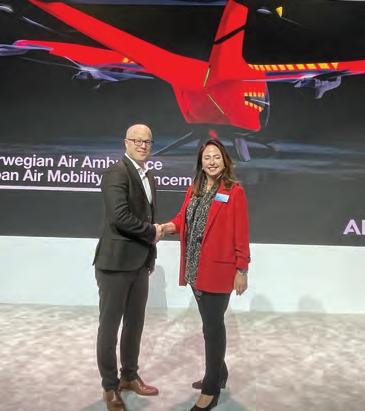
“We’re not trying to replace helicopters,” Muniz assured the Heli-Expo audience. “We’re trying to make that incredible experience much more commonplace and affordable to many more people.”
So, assuming the AAM sector scales up at the rate its advocates expect with tens if not hundreds of thousands of aircraft, how is the air-crew-starved industry going to find enough pilots to fly them all?
Beta and Archer accept that will present a significant challenge, but believe the novelty and energy behind the new mode of air transportation could re-energize the workforce. “We think there is some synergy between this need and the Part 121 [commercial airline] pilot shortage,” Muniz maintained. “United is excited to give pilots coming out of its Aviate flight training school [the opportunity] to fly our Part 135 operations to get up to the hours they need.”
Buckles agreed that AAM could become a conduit for attracting new pilots and technicians while stressing that the new sector will need a solid plan to ensure that the right skills are in place. “With all-electric aircraft, there are things that could hurt you really quickly if you don’t have the right training,” he concluded.
CONVENTION NEWS
JAMES HOLAHAN (1921-2015), FOUNDING EDITOR
WILSON S. LEACH, FOUNDER & CEO
EDITOR-IN-CHIEF – Matt Thurber
PRESS ROOM EDITOR – Gregory Polek
PRESS ROOM MANAGING EDITOR – Kerry Lynch
THE EDITORIAL TEAM
Charles Alcock
Curt Epstein
Mark Huber
Mario Pierobon
Panelists participated in an “Embracing Equity” discussion on Wednesday at Heli-Expo in Atlanta held in celebration of International Women’s Day.

continued from page 1
That includes turning to helicopter pilots and transferring them to fixed-wing aircraft, McKay continued. “They’re doing this very successfully…Anybody who was a helicopter pilot is being thrown so much money, so many signing bonuses, [and] a really clear [mandate] to keep growing in their career,” she lamented. “The helicopter industry needs to come together and figure out how do we grow our own population and then retain it.”
Other panelists gave key advice on the need for managers’ willingness to lead on diversity. “Everyone plays a role,” said Linda Deslatte, v-p
of commercial programs for Bell. “I would love it if everybody went home today and tried to think about how they were promoting equality in the workplace. As leaders, as engineers, you can be mentors from anywhere you are.”
Women, said CH-47 Chinook captain Fallon Blattner, have to get used to being “the first.”
“Almost a hundred percent of the time I am the only female pilot,” said Blattner, who works as a contract pilot. On many occasions, she received support from managers, who pointed out she was the first female pilot they hired or to get a certain type rating. “For me personally, I don’t even know that. It’s my job. I go to work, I do the best that I can,” she concluded. z
Yellowhead Helicopters has selected Camp Systems’ (Booth B3825) aviation management products to provide aircraft health management for its fleet of 48 aircraft. Camp offers maintenance tracking integrated with its enterprise resource planning (ERP) software to provide tracking, planning, execution, and compliance in a single ecosystem.
“Camp’s ability to document compliance from start to finish was a strong determining factor in choosing the platform,” said
Yellowhead CEO Jacob Forman.
Privately-held Yellowhead is based in British Columbia and Alberta, Canada, and has operated since 1975. A holding of media company Hearst, Camp has provided aviation-related products and services for more than 50 years.
Peter Shaw-Smith Chad Trautvetter
Hanneke Weitering
PRODUCTION MANAGER – Martha Jercinovich
GRAPHIC DESIGNERS – Alena Korenkov, John A. Manfredo, Grzegorz Rzekos
PHOTOGRAPHER – Mariano Rosales
DIRECTOR OF VIDEO – Ian Whelan
CHIEF OPERATING OFFICER – Dave Leach
PRESIDENT - Ruben Kempeneer
VICE PRESIDENT SALES & MARKETING – Karl H. Elken
SENIOR DIRECTOR, INDUSTRY AFFAIRS AND EVENTS – Nancy O’Brien
ADVERTISING SALES
Michelle James – Midwestern U.S., Western U.S./Western Canada/Asia Pacific, +1 (520) 343-0236
Karl H. Elken – Mid-Atlantic U.S./Southeast U.S./Caribbean/ Brazil, +1 (201) 444-5075
Diana Scogna – Europe/Middle East, +33 6 62 52 25 47
Victoria Tod – Northeastern U.S./Eastern Canada/Great Lakes U.S./United Kingdom, +1 (203) 733-4184
Yury Laskin – Russia, +7 05 912 1346
AUDIENCE DEVELOPMENT DIRECTOR – Eileen Silberfeld
MARKETING AND CLIENT SERVICES MANAGER – Lisa Valladares
SOCIAL MEDIA MARKETING – Zach O’Brien
SALES ADMINISTRATOR – Cindy Nesline
DIRECTOR OF FINANCE & HUMAN RESOURCES – Michele Hubert
ACCOUNTS PAYABLE – Mary Avella
ACCOUNTS RECEIVABLE – Bobbie Bing
U.S. HEADQUARTERS:
214 Franklin Ave., Midland Park, NJ 07432, +1 (201) 444-5075
Advertising Inquiries: +1 (201) 345-0085, adsales@ainonline.com
Circulation Inquiries: +1 (201) 345-0085
subscriptions@ainonline.com
WASHINGTON, D.C. EDITORIAL OFFICE: Kerry Lynch (business aviation) – klynch@ainonline.com +1 (703) 969-9195
EUROPEAN EDITORIAL OFFICE: Charles Alcock – calcock@ainonline.com, Tel: +44 7799 907595
HAI Convention News is a publication of the AIN Media Group, Inc., 214 Franklin Ave., Midland Park, NJ 07432; Tel.: +1 (201) 444-5075. Copyright © 2021 All rights reserved. Reproduction in whole or in part without permission of AIN Media Group, Inc. is strictly prohibited. AIN Media Group, Inc. publishes Aviation International News, AINalerts, AIN Air Transport Perspective, Business Jet Traveler, BJTwaypoints, ABACE Convention News, Dubai Airshow News, EBACE Convention News, Farnborough Airshow News, FutureFlight.aero, LABACE Convention News, MEBAA Convention News, NBAA Convention News, Paris Airshow News, Singapore Airshow News, Mobile Apps: Aviation International News; AINonline. PUBLICATION MAIL AGREEMENT NO. 40649046 RETURN UNDELIVERABLE CANADIAN ADDRESSES TO: PITNEY BOWES INTERNATIONAL MAIL, STATION A, P.O. BOX 54, WINDSOR, ON, N9A 6J5, returns il@imex.pb.com.
THE CONVENTION NEWS COMPANY, INC.
AIN PUBLICATIONS EXECUTIVE TEAM
Wilson Leach Jennifer Leach English Karl H. Elken
M.H.
“Our helicopter customers face a dynamic, competitive market,” said Camp president Sean Lanagan. “CAMP is proud to be a partner in meeting this challenge.”
Matt Thurber Dave Leach Ruben Kempeneer
Michele Hubert Nancy O’Brien
Printed by Geographics, Atlanta GA


